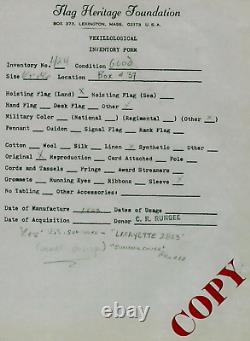VERY RARE U. S. S Lafayette Summer Cover Flag Swatch Display JG Autographs COA






Own a piece of American history! S Lafayette Summer Cover Flag Swatch Display. This item is certified authentic by JG Autographs and comes with their Certificate of Authenticity.
Converted to an ironclad ram, in the. On 18 May 1862 for use in the. She was converted to an ironclad. On 8 September 1862, she was transferred to the Navy with the entire western flotilla by executive order on 1 October 1862. 27 February 1863, with Captain.
The new ram joined Rear Admiral. On 16 April 1863 past the deadly batteries which protected the vital.
Engaged the southern guns as they shepherded Army transports through the gauntlet to. Was lashed to the starboard side of. Also towed a coal barge. The successful steaming of the squadron past the heavy batteries contributed to the early seizure of.The eventual fall of Vicksburg itself, and ultimately the conquest of the entire. Five days later Porter, in. Reconnoitered the Confederate works at Grand Gulf.
He found a "strong fort" under construction and shelled the workers out. Attempted to land supplies for the fort the Union gunboats drove her back up the. By the 24th, Porter had stationed his gunboats so that they commanded the upper battery at Grand Gulf and closed off the mouth of the Big Black River." In the 5½-hour battle, the gunboats silenced the lower batteries but could succeed in stopping the fire from the upper forts only "for a short time. Meanwhile, Army transports passed safely below the batteries.
Were "pretty much cut up" in the engagement, the expedition was successful, and the net result was summed up by Porter, We are now in a position to make a landing where the general [Grant] pleases. Took advantage of this mobility and ferried his troops across the Mississippi and landed them at. For lightning operations to isolate Vicksburg from reinforcements.
On 3 May Porter once again moved his gunboats against the Confederate batteries, but the southerners, finding their position totally untenable after Grant had taken his army into the country back of Grand Gulf, had evacuated. The great land-sea pincer could now close on Vicksburg. The Navy holds the door to Vicksburg. Porter departed Grand Gulf with his gunboat squadron and rendezvoused that evening with the Farragut fleet at the mouth of the Red River. He preceded up the river the next day with. "A powerful casemated work" which the Confederates had recently evacuated in the face of the naval threat. Porter pushed past a heavy obstruction in the river and proceeded to. Which he occupied on the morning of the 7th. As the Union noose around Vicksburg tightened. Steamed up and down the river gathering information and dispersing Confederate defensive works. 4 June, forcing the defenders to abandon strong riverside positions. Exactly a month later, on Independence Day, Vicksburg surrendered, ending a long and valiant siege. During the summer and fall.On 29 September she and. To support troops under Major General. There more than 400 Union troops recently had been captured in an engagement with Confederates under Brig.

